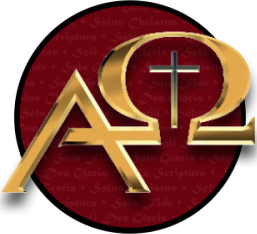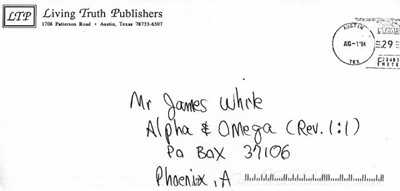A few days ago I just happened to see a series of posts on the topic of the Comma Johanneum (1 John 5:7, KJV) in a mail list I scan through (but rarely read). Someone was asking for information on the topic as a lady in a Bible study had “freaked out” to discover the variant. I was once again reminded of just how vital it is for believers to know how to explain and ground new converts in a sound historical view of where the Bible came from. Anyway, as I scrolled down the few replies, I ran into one from the KJV Only perspective, and no rebuttals of it offered. I just sighed. “Another confused person created thanks to the traditions of men.”
The link took me to good ol’ Tom Holland and his defense of the Comma Johanneum. Now, let me say up front: while I disagree with Byzantine priority, etc., at least that position can put together some form of defense of its position. But I draw the line with the Comma. Anyone who defends the insertion of the Comma is, to me, outside the realm of meaningful scholarship, unless, I guess, they likewise support the radical reworking of the entire text of the New Testament along consistent lines (and no, I have never, ever met anyone who wanted to do that—every defender of the Comma I have met defends the KJV, hence, their inherent inconsistency is, to me, proof of their holding to tradition over against truth).
Right off the bat I caught Dr. Holland playing with the facts, as he must, to defend this plainly uninspired insertion. Here’s the claim:
The External Support: Although not found in most Greek manuscripts, the Johannine Comma is found in several. It is contained in 629 (fourteenth century), 61 (sixteenth century), 918 (sixteenth century), 2473 (seventeenth century), and 2318 (eighteenth century). It is also in the margins of 221 (tenth century), 635 (eleventh century), 88 (twelveth century), 429 (fourteenth century), and 636 (fifteenth century). There are about five hundred existing manuscripts of 1 John chapter five that do not contain the Comma. It is clear that the reading found in the Textus Receptus is the minority reading with later textual support from the Greek witnesses. Nevertheless, being a minority reading does not eliminate it as genuine. The Critical Text considers the reading Iesou (of Jesus) to be the genuine reading instead of Iesou Christou (of Jesus Christ) in 1 John 1:7. Yet Iesou is the minority reading with only twenty-four manuscripts supporting it, while four hundred seventy-seven manuscripts support the reading Iesou Christou found in the Textus Receptus. Likewise, in 1 John 2:20 the minority reading pantes (all) has only twelve manuscripts supporting it, while the majority reading is panta (all things) has four hundred ninety-one manuscripts. Still, the Critical Text favors the minority reading over the majority in that passage. This is common place throughout the First Epistle of John, and the New Testament as a whole. Therefore, simply because a reading is in the minority does not eliminate it as being considered original.
The knowledgable reader can see through this argument with a glance: sadly, most lack the background to see how inconsistent and irrelevant the argument actually is. Let’s unpack it:
1) Note the dates on the manuscripts supporting the Greek of the Comma are all so young as to be, for all intents and purposes, irrelevant. Many are written post-printing press! Even citing such manuscripts without even attempting to make an argument that they have any connection to the ancient text at all is embarrassing.
2) “Being a minority reading does not eliminate it as genuine.” Spoken like a true follower of Westcott and Hort! Of course, remember, in the vast majority of instances, Holland and all other KJV defenders are arguing that God preserved the the “received” text in the “majority” of manuscripts. Inconsistency is the hallmark of traditionalism, and here you have it coming out strongly. From a “reasoned eclectic” viewpoint, of course being in minority status does not preclude the originality of the reading: the only folks who would disagree, evidently, are the Majority Text folks. No one says otherwise, so why make such a statement? What the vast, vast, vast majority of believing scholarship would say is, “being supported by a tiny group of exceptionally late, next-to-worthless witnesses without a scintilla of ancient textual support precludes you from originality.”
3) The citation of 1 John 1:7 is deceptive and misleading, and Holland should know it. Yes, twenty four manuscripts support the reading, and they happen to be twenty four of the most ancient manuscripts of 1 John. Not only is the variant not parallel to the Comma, but the textual data is actually the exact opposite in that the “minority” reading is the ancient reading! The same is true of 1 John 2:20, though not quite as strongly, and in both instances, there are other issues in play that have no parallel to the Comma either.
4) To take two readings where the “Critical Text” has consistently gone with the most ancient manuscripts over against much later ones and then conclude, “Therefore, simply because a reading is in the minority does not eliminate it as being considered original” is nothing less than deceptive and purposefully misleading when applied to the Comma. If Holland had wished to be taken seriously in such a statement, he would have to at least note the ancient nature of the textual data used by the Critical Text and then tried, somehow, to explain how these texts are at all relevant in light of these facts. But he does not. In fact, he specifically avoids mentioning the dating of these manuscripts, and there is only one reason: he knows giving the whole story would undercut his own position.
This brand of TR Onlyism/KJV Onlyism is defenseless apologetically in the face of anyone who seeks consistency in the application of textual methodology. And for that reason, it should be abandoned by all who recognize the need to defend the Scriptures in a meaningful fashion.



